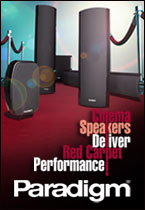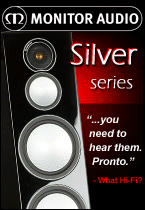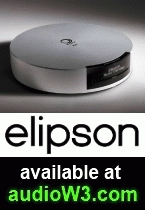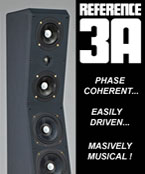My dad bought a Leak Stereo 30 amp, back in the sixties. It was one of the first, perhaps the first, stereo transistor integrated amp. Until recently, not much has changed in the world of amplification. Certainly there have been numerous refinements to the sound, and amps have become more powerful and better looking. Along the way, many have lost the ability to accept turntable inputs, and tone controls have largely been banished. Only in the last few years has a new type of amplifier arrived on the scene – one equipped for the age of the computer, internet streaming and smartphones.
Following our review of the NAIM UnitiQute, here comes another Swiss-army-knife amplifier, the Micromega AS400 Integrated Amp ($4,795) - this time from France. Here we have a powerful Class D amplifier, incorporating AirStream networking. This means that I can play music from iTunes on my notebook computer, or directly from my iPhone/iPad, without any connecting cables.
You may remember some fine CD players from Micromega but it is no secret the company ran into financial difficulties a few years back, and has been reincarnated by its new owner, Didier Hamdi. Welcome back Micromega! The AS400 was strutting its stuff to very good effect at CES 2011 in Vegas and again at the Montreal Festival Son & Image this spring.
Let’s see how flexible this package really is. There’s a minijack on the front panel to plug in an MP3 player. This falls short of the NAIM UnitiQute’s ability to source the digital output of an iPhone or iPad through a USB connection cable but is still a welcome inclusion.
Another nice feature is the headphone output (minijack) on the front panel, which performs very well with headphones of high or medium sensitivity. The maximum volume level (a range of 1 to 15 is offered in headphone mode) cannot drive my very inefficient Sennheiser HD800 phones to realistic volume levels on some low level recordings, but the quality is surprisingly good at all times. It does an excellent job driving the slightly more efficient AKG K701s and also my high efficiency canal earphones. Unusually, you control whether output flows to the speakers or to the headphones via a push button, while on many amps switching happens automatically as you insert the headphone jack. For additional flexibility the AS400 boasts a tape monitor, preamp out, sub out (with a 3dB cut-off at 400Hz), a processor input (to bypass the preamp section) and an RS232 remote connection. It’s a nice bonus to be able to rename the three standard analog inputs.
The volume control uses an advanced digitally controlled resistance ladder with 70 steps calibrated in dBs and has a very nice feel to it. It is also speed sensitive which makes it easy to make large changes quickly. There’s a balance control too, but it’s hidden – you have to press and hold the Mute button, then turn the volume control.
The very attractive casework is available in a silver or black satin finish. The unit looks and feels considerably more expensive than the asking price. Did I tell you the AS400 was heavy? It weighs 13kg, surprising for an amp less than 10cm high. Most of that weight is on the right hand side, so be careful when lifting, lefties!
If there is one minor area that Micromega has let us down, it’s the remote control. It works well enough but has row upon row of almost identical buttons including buttons to control other Micromega components. It’s also a little quirky. There is a button for display down and another for display up. The first turns off the display, while the second toggles the display between off and on. There is no direct selection for the various inputs on the machine, or the remote – you can only go next or previous on the front panel, and just next from the remote. However, you can improve matters by removing unused inputs in the menu system.
An amp with as many features as this deserves a comprehensive instruction manual, and Micromega has skimped here – there isn’t even a picture of the rear panel of the unit or the remote control in the four pages provided. Some of the information, such as the password for the MUSIC network, is incorrect or incomplete. I hope they can add some updates on their website to cover these deficiencies, but your dealer will certainly be able to help with any questions you may have.
The big draw here is of course the very latest and most advanced AirStream technology, included for the first time in an audiophile integrated amp. A colour coded AirStream logo indicates network status – red for off, blue for on. Based on Apple’s Airport Express the AirStream module has four components:
• Power Supply
• Master Clock
• D/A Converter
• Analog Output
The power supply is a very complex device with separate outputs for each of the other three components. The Master clock is a low jitter device made exclusively for Micromega, while the DAC section features a Cirrus Logic 4351 device followed by a pure Class A output stage.
You can quickly set up a wireless connection between your iPhone/iPad and the AS400 and stream music from your iTunes collection. This works very well, with just the occasional hiccup when moving out of range. This is a wonderfully convenient way to operate and the sound quality of this uncompressed digital streaming and conversion to analog is very satisfying if you use Apple Lossless mode for your iTunes music library.
You can also access the iTunes library on a wireless notebook (I used my daughter’s ThinkPad) by loading the free Airport Express software. As an extra treat, you can download a free Apple app called Remote which allows you to control the iTunes on your computer from the iPhone/iPad. To get all this working I first had to update the iTunes software on my computer to the latest version (10.4) and then it all worked smoothly. Unfortunately you can’t join two networks at once so if you switch the notebook to link to the default AirStream network on the AS400 (labelled MUSIC), you lose your regular internet connection until you switch back. It is possible to join the AS400 directly to your own wireless network, but this is a more complex procedure. AirStream is set up to work with iTunes. Just select the AS400 as the destination from the “Choose which speakers to use” option at the bottom right of the iTunes screen. You can also access other digital streaming sources besides iTunes by purchasing the appropriate third party software for Mac or PC (Rogue Amoeba’s AirFoil – a $25 download).
The built-in DAC can accept AAC, AIFF, Apple Lossless, MP3, WMA and WAV files but the sampling frequency is limited to iTunes’ maximum bit rate of 16 bits and 44kHz. AirStream works on the 802.11n standard.
Class D amplification has been gaining traction because of its high efficiency, which means the power supplies and heat sinks can be smaller and hence the entire package can be made smaller and lighter, resulting in lower prices for the consumer. The AS400 runs surprisingly hot for a Class D device, and if you leave it on for a while, even without playing music, you may get a surprise when you adjust the volume level from the front panel – that knob gets fairly hot too! Of course when you are not playing music you should put the unit into standby which keeps things running relatively cool.
I started my listening by connecting up an SACD player through one of the unbalanced analog inputs. The sound quality is quite good, lively, ballsy and quick to react to transients. The bass and midrange are clean and dynamic, with plenty of low level detail and silent backgrounds. The treble region lacks delicacy and life compared to some more expensive amps, particularly when there is a lot of high energy percussion sound, and the image depth is limited. That’s why enthusiasts will shell out big bucks for state-of-the-art amplifiers that can preserve the most delicate harmonic information and offer a wider, deeper soundstage. What the Micromega may lack in finesse, it more than makes up for in raw power. Would you believe the “400” in AS400 stands for 400 watts per channel output into a 4 ohm load? To put this in perspective, the NAIM UnitiQute puts out a mere 45wpc into 4 ohms. My reference Bryston 4BSST² (a 22kg brute of a power amplifier) manages 500wpc into 4 ohms, a marginal gain in practice. With this much power on hand, you can drive a wide range of speakers that might trouble some other amps.
Finally, Micromega has not forgotten the vinyl enthusiast. There’s a high quality moving magnet phono stage built in to the AS400. When you switch to this particular input, the AirStream network switches off to prevent any possible interference with the delicate low level signal coming from your cartridge. There is plenty of gain, an even frequency response and a silent background here which shows proper care and attention have been paid to circuit design. One downside to this functionality is that when switching inputs you may have to pass through the phono input, which turns off the AirStream network. When you move on to the input you really want, it takes almost a minute to turn the network back on. Ideally I would like to see the network go on and off in seconds, and to be off at all times except when the streaming input is selected.
Overall there is a great deal to like here, tons of power, great looks, enormous flexibility, full integration with iTunes on your computer or iPhone/iPad, and compatibility with many more traditional components including your turntable. Thanks to the provision of a preamp output, you can even upgrade the sound quality later by adding a power amp of your choice, retaining all that priceless digital streaming and input flexibility. The value is outstanding and you’ll have a lot of fun with this in your system. The fact that it’s built like a tank (guaranteed 10 years) and bears the prestigious Micromega name is icing on the cake.
Micromega
www.micromega-hifi.com
Distributed in Canada by Plurison
www.plurison.com
1-866-271-5689
Micromega AS400 Integrated Amplifier
Price: $4,795 CAD
Click here to discuss this article on the CANADA HiFi Forum















